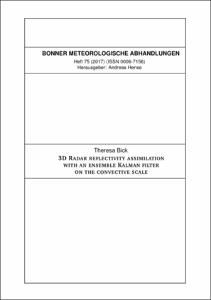3D Radar reflectivity assimilation with an ensemble Kalman filter on the convective scale

3D Radar reflectivity assimilation with an ensemble Kalman filter on the convective scale

| dc.contributor.advisor | Simmer, Clemens | |
| dc.contributor.author | Bick, Theresa | |
| dc.date.accessioned | 2020-04-23T19:16:12Z | |
| dc.date.available | 2020-04-23T19:16:12Z | |
| dc.date.issued | 10.03.2017 | |
| dc.identifier.uri | https://hdl.handle.net/20.500.11811/7117 | |
| dc.description.abstract | Atmospheric processes are governed by strongly nonlinear dynamics, and predicting convective events is a challenging task. In numerical weather prediction (NWP), an accurate description of the current state of the atmosphere is needed to initialize NWP forecasts. In order to derive these initial conditions, data assimilation plays an essential role. For convective-scale data assimilation, radar observations of precipitation represent an ideal database because of their unique ability to capture the spatial and temporal evolution of precipitation systems. A radar forward operator that simulates synthetic radar measurements based on the NWP model fields enables the comparison of observations and model states. Such a forward operator is integrated into a local ensemble transform Kalman filter (LETKF) for the assimilation of radar reflectivity data in areas with and without precipitation. Two experiments are examined. In the first experiment, the data assimilation update interval is varied (ranging from 5 to 60 minutes) and its influence on the quality of analysis and precipitation forecast is studied. While the analysis quality benefits from frequent updates, forecast quality is degraded. Additional information gained from updating frequently dissipates quickly, and the best forecast quality for lead times beyond one hour can be obtained with hourly updates. In the second experiment, radar reflectivities are assimilated for a period of seven consecutive days with significant precipitation over Germany. Precipitation forecasts initialized throughout this week are compared to those based on the current operational precipitation data assimilation scheme of Deutscher Wetterdienst (DWD), called latent heat nudging (LHN). The results show that the LETKF based assimilation of radar observations competes successfully with LHN, though LHN has been tested and tuned over several years, whereas the LETKF based system is still in an early development phase. Furthermore, the impact of the temporal and vertical resolution of the volume radar data is examined. The results suggest that reducing the vertical or temporal resolution of radar observations does not degrade forecast quality but leads to significant speed up of runtime. The results of this study are strongly encouraging and provide a promising step towards the operational use of radar reflectivities in an LETKF system in order to improve short-term forecasts of precipitation. | en |
| dc.language.iso | eng | |
| dc.relation.ispartofseries | Bonner Meteorologische Abhandlungen ; 75 | |
| dc.rights | In Copyright | |
| dc.rights.uri | http://rightsstatements.org/vocab/InC/1.0/ | |
| dc.subject.ddc | 550 Geowissenschaften | |
| dc.title | 3D Radar reflectivity assimilation with an ensemble Kalman filter on the convective scale | |
| dc.type | Dissertation oder Habilitation | |
| dc.publisher.name | Universitäts- und Landesbibliothek Bonn | |
| dc.publisher.location | Bonn | |
| dc.rights.accessRights | openAccess | |
| dc.identifier.urn | https://nbn-resolving.org/urn:nbn:de:hbz:5n-46228 | |
| ulbbn.pubtype | Erstveröffentlichung | |
| ulbbnediss.affiliation.name | Rheinische Friedrich-Wilhelms-Universität Bonn | |
| ulbbnediss.affiliation.location | Bonn | |
| ulbbnediss.thesis.level | Dissertation | |
| ulbbnediss.dissID | 4622 | |
| ulbbnediss.date.accepted | 09.12.2016 | |
| ulbbnediss.institute | Mathematisch-Naturwissenschaftliche Fakultät : Fachgruppe Erdwissenschaften / Meteorologisches Institut | |
| ulbbnediss.fakultaet | Mathematisch-Naturwissenschaftliche Fakultät | |
| dc.contributor.coReferee | Potthast, Roland |
Dateien zu dieser Ressource
Das Dokument erscheint in:
-
E-Dissertationen (4442)




